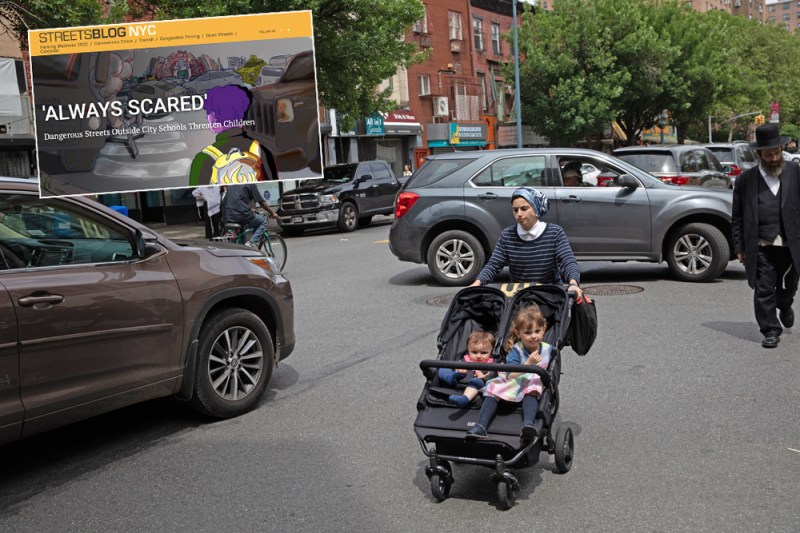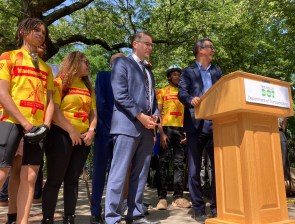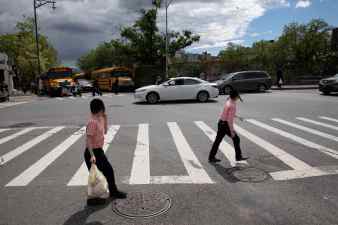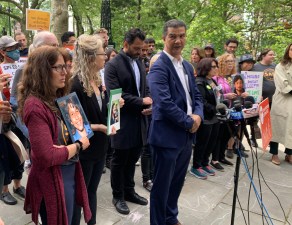How Much Does DOT Spend to Keep Kids Safe Outside of Schools? The Agency Won’t Say.

The Department of Transportation frequently touts the effort it makes to improve street safety for kids, yet the agency doesn’t know — or simply won’t say — how much money it spends on projects or salaries devoted exclusively to safety around schools.

It’s a question Streetsblog has been asking the agency since last May, when our investigation revealed the unique threat that cars pose to children on streets with schools — where there are 57 percent more crashes and 25 percent more injuries per mile than on the city’s other streets on school days.
The investigation also revealed that streets are especially dangerous outside schools where most students are poor or children of color. In the 2019 school year, for example, the rate of people injured by drivers on school days was 43 percent higher outside school buildings where a majority of students were brown or Black than outside school buildings with majority-White students.
Prior to publishing the story, Streetsblog repeatedly asked DOT for information regarding how much it spends annually on school street safety — both on payroll and other costs. Our first question established a pattern of inquiry that continued for more than six months: “Roughly how much money does DOT spend annually on school street safety, both on payroll, projects and any other costs?” Streetsblog asked in May 2022. “How has that annual figure changed in recent years?”
The agency declined to answer beyond saying that many of the agency’s projects promote safety around schools so it would be difficult to quantify its investment specifically in school street safety. And at the time, Commissioner Ydanis Rodriguez promised to make 100 street safety projects, some of which would be near schools, but it remained unclear how much of the agency’s resources were directed specifically at addressing the specific threat kids face near schools.
So on June 30, 2022, Streetsblog submitted a formal request under the Freedom of Information Law for the information. Specifically, Streetsblog requested records indicating the amount DOT has spent each year, from fiscal year 2013 through FY 2022, on school safety projects, including, but not limited to:
- payroll for the School Safety Unit, a DOT team responsible for improving street safety around schools whose work is described here
- construction costs for School Safety projects undertaken by that School Safety Unit.
- contractor or subcontractor costs.
On Dec. 30 — exactly six months later — an unidentified official in the DOT FOIL office denied the request, writing, “A diligent search for records responsive to your request did not locate any such records.”
In a separate FOIL request, Streetsblog did learn the basic staffing of the School Safety Unit, which is a part of the “transportation planning and management” staff. Here is what the School Safety Unit staff chart looks like (redactions were made by DOT):

After receiving the rejection on the larger Freedom of Information Law request, Streetsblog sought more information from the DOT, which said that it doesn’t break out specific costs for operational projects which are funded from the agency’s overall $1.3-billion budget. The agency again said on background that it’s difficult to know how much came from which part of the budget because it doesn’t break out specific project costs.

And, obviously, all street safety improvements — even a bike lane three miles from a school — adds to safety for all residents, including students. The agency said that because of that, most of its street improvement projects could count at least partly towards the total expenditures on school safety.
An agency spokesperson said salaries are straightforward, yet the agency has not provided a list of those salaries, despite many requests.
The City Council’s Education Committee Chair Rita Joseph said she was disappointed by DOT’s recalcitrance.
“Making all streets, especially streets around schools where young people congregate, is a common-sense issue,” Joseph told Streetsblog. “I know that both Mayor Adams and Commissioner Rodriguez are committed to ending traffic violence, so it’s disappointing that the DOT hasn’t disclosed these figures. New Yorkers deserve to know how the DOT is working to make school streets safer, and the city needs to do right by our young people, parents, and educators.”
Joseph’s Education Committee colleague Shahana Hanif (D-Park Slope) was also alarmed.
“I’m incredibly concerned to learn that the Department of Transportation cannot answer basic questions about street safety projects around our schools because they simply do not keep track of such projects,” she said. “If we want to ensure our students are safe at dangerous intersections, we need to make sure DOT is tracking street safety improvements around our schools.”
Advocates agreed that the “lack of transparency” (as one put it) is frustrating.
“Either you’re spending way too much considering the awful outcomes, or you’re not spending nearly enough, and you know you should be better,” said Emily Stutts, a Brooklyn public school teacher and safe streets advocate. “Families deserve to know.”
Geo Marin, whose daughter was killed by a driver as she walked to school in Queens in 2016, called DOT’s inability to say how much it spends on school street safety “bogus.”
“How could there not be a report of who does what and how much they’re making and how much they’re spending?” he asked. “It’s like they’re hiding something. What do they have to hide?”
Even when the DOT isn’t hiding anything, its ability to keep kids safe from cars is sometimes limited. For example, the agency oversees the city’s open streets program for schools, which allows any city school to remove cars from a street near the institution so that children can use the space for learning or recreation. But very few schools are taking advantage of the program, rued Jackson Chabot, director of Advocacy and Organizing at Open Plans.
“Considering how dangerous streets near schools are, and how apparently strapped for resources DOT is, broad knowledge about the program should be an agency priority,” he said. “In the meantime, we’ve started engaging directly with schools to fill the gap.”
The advocacy group has created an online toolkit (with Transportation Alternatives) to give schools step-by-step guidance to successfully apply for a school street.
The Department of Transportaion is not the only agency to resist Streetsblog’s efforts to demonstrate how much work has been done, or money spent, on the quest for safer streets around schools. In September, the Department of Education kicked a Streetsblog reporter out of a press conference when the reporter sought to question Schools Chancellor David Banks about street safety.
That incident came after Streetsblog had been seeking information from the department both before and after publishing the investigation into school streets.
The agency refused to talk about the issue, declining to answer questions or make any officials available for an interview.
— With Jesse Coburn
Correction: An earlier version of this story misconstrued a DOT assertion about why it is difficult to know how much the agency spends on specific projects. Resources for all DOT projects come from many parts of the budget, making it difficult to break out specific project costs.



